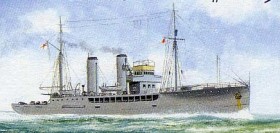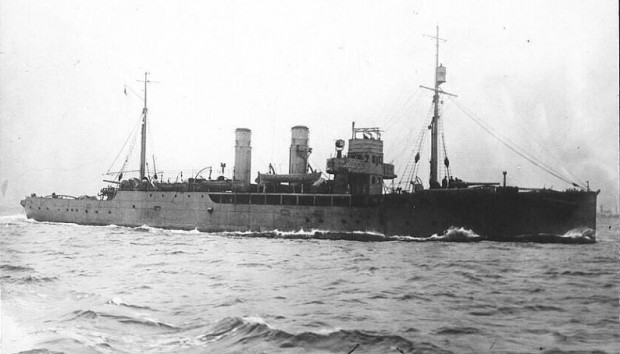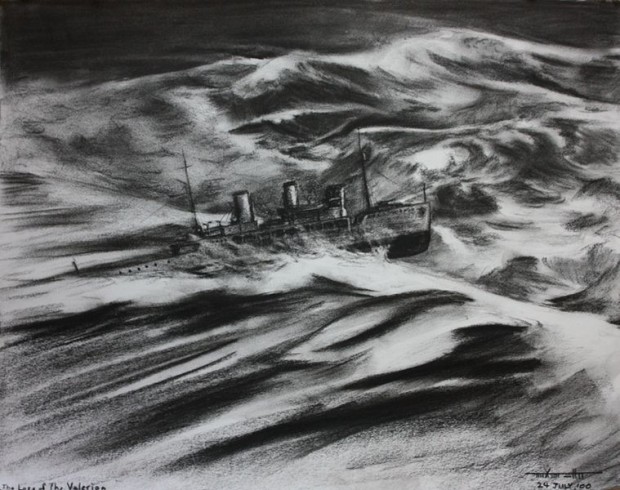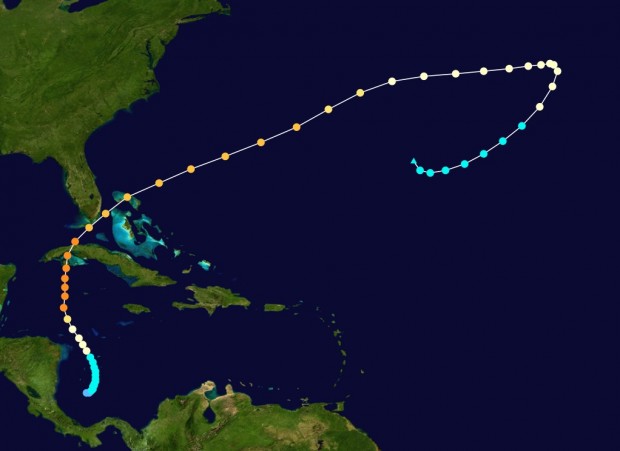1926 Bermuda Hurricane Sank UK Warship
 It remains one of the worst peacetime disasters in the Royal Navy’s history, the loss of HMS “Valerian” just a few miles off Bermuda during the catastrophic 1926 hurricane season.
It remains one of the worst peacetime disasters in the Royal Navy’s history, the loss of HMS “Valerian” just a few miles off Bermuda during the catastrophic 1926 hurricane season.
Launched in 1916 and used for minesweeping and patrol duties, the “Valerian” was returning to Bermuda in October, 1926 after assisting in hurricane relief efforts in the Bahamian out islands which had been devastated by hurricanes in July and September.
As the “Valerian” was steaming towards the island, another tropical storm developed in the southwest Caribbean Sea — the tenth of the 11 spawned during Atlantic hurricane season that year.
What became known as the “Havana/Bermuda Hurricane” moved northward, becoming a major storm on October 20 before crossing Cuba — where winds measured at 145 mile per hour caused massive damage and hundreds of deaths — before veering towards Florida.
Heading northeastward again, it strengthened into a Category 4 before hitting Bermuda on October 22.
While meteorologists in Bermuda knew of the storm’s approach, it covered the thousand miles from the Bahamas to Bermuda so rapidly it apparently struck with few warning signs aside from heavy swells.
On October 21, with the eye of the storm still 700 miles from Bermuda, weather forecasts from the US called for it to strike the island on the following morning with gale force.
British war sloop “HMS Valerian” foundered in a hurricane off Bermuda in 1926
The Arabis class war sloop HMS “Valerian”, based at the His Majesty’s Dockyard in Bermuda, was returning from providing hurricane relief in the Bahamas and was overtaken by the storm shortly before she could make harbour.
Unable to enter through Bermuda’s reefline, the 268-foot HMS “Valerian” fought the storm for more than five hours before she was sunk with the loss of more than 80 members of her crew.
She was less than five miles from the safety of Dockyard when she went down.
The British merchant ship the “Eastway” was also sunk near Bermuda during the hurricane. Only 12 members of her 35-man crew were plucked from the sea alive.
The “Valerian’s” commanding officer, Commander W.A. Usher, reported that there was no sign of a major storm at 8 a.m., when his ship was in sight of Bermuda, and when the British Army meteorologists at Prospect Camp measured the wind at 28 miles per hour.
Only when the handful of survivors of the “Valerian” were plucked from the seas the following day did the full extent of the tragedy become apparent. Four officers and 84 men had gone down with the ship while only 19 men were rescued by HMS “Capetown” which had safely ridden out the storm at sea.
The storm became extratropical on October 28.
Artist’s impression of the loss of HMS “Valerian” off Bermuda
But by 10 a.m., the winds had reached 95 miles per hour. When the centre of the storm passed over Bermuda at noon, the winds dropped to eight miles per hour, then increased to 114 miles per hour, whereupon the Army took down its anemometer to protect it.
The Royal Naval Dockyard was being hammered severely and never took its anemometer down. It measured winds of 138 miles per hour at 1 p.m. — about the same time the “Valerian” went down — before the wind destroyed it.
Track of the October, 1926 “Havana/Bermuda Hurricane”
In 1927 British ship owner Watkin James Williams, 46, was found guilty by a Cardiff court of sending the British the steamship “Eastway” to sea in an unseaworthy condition and was sentenced to one year’s imprisonment.
A British court-martial acquitted survivors of the “Valerian” of any blame for the ship’s loss.
A commemorative plaque for those who lost their lives aboard HMS “Valerian” once hung at the Dockyard’s Royal Naval Chapel but was later moved to Commissioner’s House at the National Museum.





A very interesting piece of history! Thanks.
Excellent account and compilation. Timely piece. Thanks!
Does anyone have any idea of her location? 5 Miles out of DY could have put her inside the edge.
A good ways out to the W of SW Breaker.
http://www.wrecksite.eu/wreck.aspx?457
Through researching Family History I am led to this site. Interesting, and sad piece of history regarding those ships that sank and the tragic loss of life. At the same time as these tragedies occured, my grandfather was a crewman aboard the Fort St George of the Furness Bermuda Line, that ran between New York and Bermuda. The ship Fort St George managed to ride out the storm of that day 22 Oct 1926, presumably while at Bermuda or in the area. Survivors of the Eastway were taken aboard the Fort St George, from Bermuda on 23rd Oct, arriving New York on 25th October.
The Artist’s rendition shown at the bottom of this article was drawn by my son Sean Talbot(aka Seán Pòl Ó Creachmhaoilan)and was taken from this Wikipedia Page:
http://en.wikipedia.org/wiki/File:The_Loss_of_the_Valerian.JPG
I’ve also written a fair bit about it in past, including on Wikipedia: http://en.wikipedia.org/wiki/1926_Atlantic_hurricane_season#Havana_hurricane
More importantly, on my defunct Geocities website, killed off by Yahoo’s mercenaries several years ago, but which has thoughtfully (and without my consent) been preserved by archival sites: http://www.geocities.ws/gpvillain/valerian.html
Most usefully, I transcribed the court martial report , as published in the Royal Gazette on the 3rd of November, 1926 (verbatim, with all typos included): http://www.geocities.ws/gpvillain/news3novpg1.html
My grandfather Frank Norton was an officers steward serving on the Valerian when she went down.
Sadly he did not survive and left my grandmother and 3 small children.
My sister and I read the transcript of the court martial, and as upsetting and heartbreaking as it was, it answered lots of questions.We never knew our grandfather but we know he was a hero along with all his shipmates that sadly lost their lives that day.
Kind regards
J.Cruickshank.